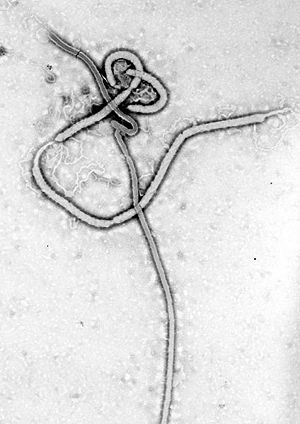Ebola virus: Difference between revisions
| Line 1: | Line 1: | ||
==Introduction== | ==Introduction== | ||
<br>Ebola virus is a RNA | <br>Ebola virus is a member of the Filoviridae viral family of RNA viruses, which are characterized by the long, thin filaments seen in micrograph images. It is named after the Ebola River where the virus was first discovered. <br>The virus causes Ebola hemorrhagic fever, which is a serious and usually fatal disease for those who contract it. It damages the endothelial cells that make up the lining of the blood vessels and creates difficulty in coagulation of the infected individual’s blood. As the vessel walls become more damaged, and the platelets cannot coagulate, the individual undergoes hypovolemic shock, or a dramatic decrease in blood pressure. Depending on the type of virus, Ebola can have up to a 90 percent mortality rate for those infected.<br>Ebola hemorrhagic fever has been reported in humans only in Africa. <br><br>There are several different types of Ebola virus that effect humans. Currently they are Zaire, Sudan, and Ivory Coast Ebola virus, named for the respective regions in Africa in which the strain was found. Reston Ebola virus is a type of Ebola that only infects non-human primates. It was first discovered in an outbreak in Reston, Virginia. Outbreaks of Ebola are sometimes caused by new strains of the virus; so more types can and are being discovered. For example, in 2007 there was an outbreak of Ebola hemorrhagic fever in the Bundibugyo District of Uganda where a new strain of the virus, as classified according to the Center for Disease Control, was found to be the cause. <br>Ebola virus is a large concern of public and global health because very few humans have been found that are immune to the disease and it has such a high mortality rate that it is a very dangerous virus and a potential bioterrorism agent. <br> | ||
[[Image:Ebola pic.jpg|thumb|300px|right|Electron micrograph of the Ebola Zaire virus. This was the first photo ever taken of the virus, on 10/13/1976. By Dr. F.A. Murphy, now at U.C. Davis, then at the CDC.]] | [[Image:Ebola pic.jpg|thumb|300px|right|Electron micrograph of the Ebola Zaire virus. This was the first photo ever taken of the virus, on 10/13/1976. By Dr. F.A. Murphy, now at U.C. Davis, then at the CDC.]] | ||
Revision as of 04:49, 8 December 2009
Introduction
Ebola virus is a member of the Filoviridae viral family of RNA viruses, which are characterized by the long, thin filaments seen in micrograph images. It is named after the Ebola River where the virus was first discovered.
The virus causes Ebola hemorrhagic fever, which is a serious and usually fatal disease for those who contract it. It damages the endothelial cells that make up the lining of the blood vessels and creates difficulty in coagulation of the infected individual’s blood. As the vessel walls become more damaged, and the platelets cannot coagulate, the individual undergoes hypovolemic shock, or a dramatic decrease in blood pressure. Depending on the type of virus, Ebola can have up to a 90 percent mortality rate for those infected.
Ebola hemorrhagic fever has been reported in humans only in Africa.
There are several different types of Ebola virus that effect humans. Currently they are Zaire, Sudan, and Ivory Coast Ebola virus, named for the respective regions in Africa in which the strain was found. Reston Ebola virus is a type of Ebola that only infects non-human primates. It was first discovered in an outbreak in Reston, Virginia. Outbreaks of Ebola are sometimes caused by new strains of the virus; so more types can and are being discovered. For example, in 2007 there was an outbreak of Ebola hemorrhagic fever in the Bundibugyo District of Uganda where a new strain of the virus, as classified according to the Center for Disease Control, was found to be the cause.
Ebola virus is a large concern of public and global health because very few humans have been found that are immune to the disease and it has such a high mortality rate that it is a very dangerous virus and a potential bioterrorism agent.
To upload an image: Use "Upload File" (in margin at left)
To make the image appear, you need to embed image insertion code (see sample at right). The insertion code consists of:
Double brackets: [[
Filename: PHIL_1181_lores.jpg
Thumbnail status: |thumb|
Pixel size: |300px|
Placement on page: |right|
Legend/credit: Electron micrograph of the Ebola virus. This image was taken from Wikipedia.
Closed double brackets: ]]
Other examples:
Bold
Italic
Subscript: H2O
Superscript: Fe3+
History
Include some current research in each section.
Transmission
Include some current research in each section.
Symptoms
Include some current research in each section.
Prevention and Treatment
There is currently no treatment or vaccine for Ebola.
Prevalence and Relation to Global Health
Ebola has mainly occured in Africa, with the exception of the outbreak in Virginia.
Conclusion
Overall paper length should be approximately 2,000 to 2,500 words.
Include at least two data figures.
Use professional sources, including at least two research studies.
This page was created by Andie Asimes.
References
Edited by student of Joan Slonczewski for BIOL 191 Microbiology, 2009, Kenyon College.

